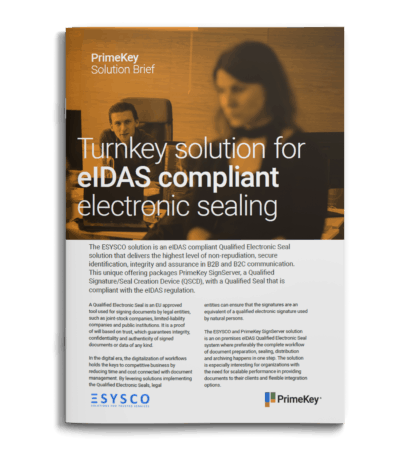documents by legal entities such as join-stock companies,
limited-liability companies and public institutions.
It is a solution-based on trust, which guarantees integrity
and authenticity of the data sources it is connected with.
Request FREE DEMO
Finance and insurances
Business
Public administration
Health care
Key business goals and benefits
Improved and efficient
automatization processes
Reduction of time and costs
connected with document
Higher level of legal certainty for organizations which implement innovative solutions
Legally binding transactions
Efficient, quick and flexible
organisation
Highest level of security
in B2B and B2 communication
Use cases for a qualified electronic seal
Solution description
Supported standards
PKCS#7, PDF & PDF/A, XAdES, EDI, LTA, ERS, timestamp
Long-term document archiving
QSeal for SmartCard and QSCD
Local QSeal with QSCD
Remote QSeal with QSCD
Key features of qualified electronic seal
Supporting shared standards,
algorithms and protocols
Documenting the achievements
Flexible integration
Mass sealing of millions of documents
per hour
High efficiency
Mass sealing of hundreds of documents
in a single step
Turnkey solution for eIDAS compliant electronic sealing
Joint solution of PrimeKey and ESYSCO enables to digitally seal even 11 million of documents per hour with highest level of integrity, non-repudiation and assurance in B2B and B2C communication – all in compliance with eIDAS and on premise. Download our Solution Brief to find out more.

Why is the QSeal
in accordance with eIDAS?
EU law and the electronic seal
eIDAS – the EU regulation (1999/93/WE) regulates electronic identification and trust services in regard to online transactions, standardises norms of the security of electronic interactions between citizens, enterprises and public institutions all over the European Union.
Thanks to the eIDAS regulation, electronic documents signed with qualified seal are treated equally as documents signed by hand.
ENISA
In November 2018, ENISA, the European Union Agency for Cybersecurity, has published and Assessment of Standards related to eIDAS Recommendations to support the technical implementation of the eIDAS Regulation. §4.3.2 states clearly that “This Protection Profile can be perfectly applied for devices that are not managed by a TSP.
A device certified against this PP may be used by users that wish to store they signing keys remotely, as it would be the case e.g. for a legal person implementing a QSCD to issue qualified seals.“
CEN/TS
In March 2019, CEN TS 419 221-6 which specifies “Conditions for use of EN 419221-5 as a qualified electronic signature or seal creation device“ was published.
This technical specification provides a clear basis for acceptance of EN 419221-5 certified devices for use as a qualified signature creation device or a qualified electronic seal creation device under Regulation 910/2014 even if not operated by a qualified TSP. In other words, the legal owner of a qualified seal can use a QSCD locally, usually on premise, for high performant local sealing of documents.
Legal aspects and certification
eIDAS requires a certified Qualified Signature (or Seal) Creation Devices (QSCD) using qualified certificates for the generation of electronic signatures and seals. Our solution is based on Utimaco’s CP5 Common Criteria Protection Profile PP EN 419 221-5 certified QSCD.
Standardisation
Apart from introducing electronic signatures and timestamps, the eIDAS regulation also introduced the procedure of electronic sealing, registering of electronic receptions/deliveries, as well as validation and conservation seals and signatures.
Legal validity and binding
The aim of all the solutions mentioned above is providing maximum security of electronic transactions carried out online, as well as giving them the same binding legal power as if they were signed on paper.

